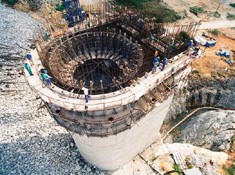Construction boosts SA economy
1 June 2007
Record expansion in construction activity helped South Africa's gross domestic product (GDP) grow by 4.7% in the first quarter of 2007, making it 34 consecutive quarters of economic growth since 1998, the longest upswing in the country's history.
The real annualised economic growth rates for the four quarters of 2006 were 5%, 5.5%, 4.5% and 5.6% respectively, Statistics South Africa (Stats SA) reported this week.
According to Stats SA, the main contributors to first quarter growth were finance, real estate and business services (1.1%); manufacturing (0.8%); wholesale and retail trade, hotels and restaurants, and construction (each contributing 0.7%); transport and communication (0.6%); and the general government sector (0.5%).
According to Business Day, growth was pulled back mainly by the country's mining sector, which contracted by 7.8% as both gold and platinum output fell.
South Africa's unadjusted real GDP at market prices for the first quarter of 2007 increased by 5.4% compared with the first quarter of 2006, Stats SA reported. The corresponding increase for the respective quarters of 2006 were 4.6%, 4.4%, 4.7% and 6.2%, yielding an annual growth rate of 5% in real GDP at market prices.
Construction boom
Overall economic growth was boosted by expansion in the construction sector, which Business Day reports grew at 21.3%, a 17-year record.
According to the paper, SA's construction industry has recorded double-digit growth since 2004 and is expected to double over the next seven years as the government rolls out its R416-billion infrastructure programme.
The bulk of that amount will be spent through electricity utility Eskom, which is building power stations to increase the country's capacity to meet soaring electricity demand, and through logistics group Transnet, which aims to revitalise the country's ageing rail infrastructure.
The government will also spend almost R15-billion on preparations for hosting the 2010 Fifa World Cup, the majority of which (over R5-billion) will go toward building five new stadiums around the country. Some R1.9-billion will be spent on upgrading five existing stadiums.
In addition, R3.8-billion has been set aside to improve public transportation and related infrastructure in the host cities, with the remainder set to go toward providing bulk services to stadiums and other supporting infrastructure.
Another major project fuelling construction is the R20-billion plus Gautrain Rapid Rail Link, which will connect Johannesburg, Sandton, Pretoria and the OR Tambo International Airport by high-speed train.
At the launch of the project in September 2006, Gauteng Premier Mbhazima Shilowa estimated that the Gautrain would create 93 000 direct, indirect and induced jobs during construction and more than 3 000 once operation commenced, contributing between 0.7% and 1% to the provincial economy.
Speaking to Business Day at the release of the Gauteng Business Barometer figures for April in Germiston this week, Standard Bank chief economist Goolam Ballim said the Gauteng construction industry was set for unprecedented growth, with more than R1.2-trillion to be spent in the three years to 2009.
According to Ballim, this figure is up from the R800-billion spent in the previous three-year period.
He told Business Day that the boom included activity in the construction industry's supply chain, including machinery and equipment, while the growth would benefit both large corporations and smaller industry players.
"Construction in Gauteng grows about 18% a year, making it the strongest sector in the province and an important employer of semi-skilled and unskilled workers, which is important," said T-Sec economist Mike Schussler.
Schussler told Business Day there was also a lot of informal construction activity in the country that was difficult to measure.
SouthAfrica.info reporter
|













